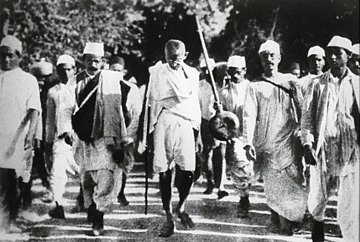On the 12th of March, 1930, Mahatma Gandhi, the revered leader of the Indian independence movement, initiated the Salt March, a historic act of civil disobedience against British salt taxes. This event, also known as the Dandi March or the Salt Satyagraha, played a crucial role in galvanizing the Indian population and drawing international attention to the struggle against British colonial rule.
Gandhi, along with a small group of followers, began the march from his Sabarmati Ashram in Ahmedabad, Gujarat. Their destination was the coastal village of Dandi, located on the Arabian Sea coast, approximately 240 miles away. The purpose of the march was to protest the British monopoly on salt production and the exorbitant taxes imposed on this essential commodity.
The Salt March was not merely a symbolic gesture; it was a carefully planned act of resistance. Gandhi and his followers walked for 24 days, covering a significant distance and gathering support from villages and towns along the way. The march served as a powerful tool to mobilize the Indian population and unite them in their fight for independence.
Upon reaching Dandi on April 6th, Gandhi performed a simple yet profound act. He picked up a handful of salt from the seawater, thereby violating the British Salt Act, which prohibited Indians from producing or selling salt independently. This act of defiance sent shockwaves throughout the country and inspired countless others to join the movement.
The Salt March gained widespread attention both within India and internationally. News of Gandhi’s peaceful protest spread rapidly, capturing the imagination of people across the globe. The march was extensively covered by the media, and images of Gandhi leading the procession became iconic symbols of resistance against colonial oppression.
The impact of the Salt March was far-reaching. It ignited a wave of civil disobedience across the country, with Indians from all walks of life joining the movement. Thousands of people began producing salt illegally, undermining the British monopoly and challenging their authority. The British government responded with force, arresting and imprisoning thousands of protesters. However, the spirit of resistance remained unbroken.
The Salt March also had significant economic implications. The production and sale of salt were essential sources of revenue for the British colonial administration. By boycotting British salt and producing their own, Indians struck a blow to the economic foundations of colonial rule. This act of non-cooperation weakened the British hold on India and further fueled the demand for independence.
The Salt March marked a turning point in the Indian independence movement. It demonstrated the power of nonviolent resistance and civil disobedience as effective tools for social and political change. Gandhi’s philosophy of Satyagraha, or truth-force, emphasized the importance of peaceful protest and the willingness to endure suffering for a just cause. The Salt March embodied these principles and inspired similar acts of resistance around the world.
Today, the Salt March stands as a testament to the indomitable spirit of the Indian people and their unwavering commitment to freedom. It serves as a reminder that even in the face of seemingly insurmountable odds, peaceful resistance can bring about transformative change. The legacy of the Salt March continues to inspire movements for justice and equality worldwide.
To learn more about the Salt March and its historical significance, you can refer to the following external references:
1. “The Salt March” – National Gandhi Museum: [Link to external reference]
2. “Gandhi’s Salt March: The Making of a Legend” – BBC: [Link to external reference]
3. “The Salt Satyagraha” – Indian National Congress: [Link to external reference]
4. “Gandhi’s Salt March: A Milestone in the Indian Independence Movement” – History: [Link to external reference]
In conclusion, the Salt March of 1930 was a pivotal event in the Indian independence movement, symbolizing the power of peaceful resistance against colonial oppression. Gandhi’s act of civil disobedience galvanized the Indian population and drew global attention to the struggle for freedom. The Salt March remains an enduring symbol of courage, determination, and the quest for justice.

